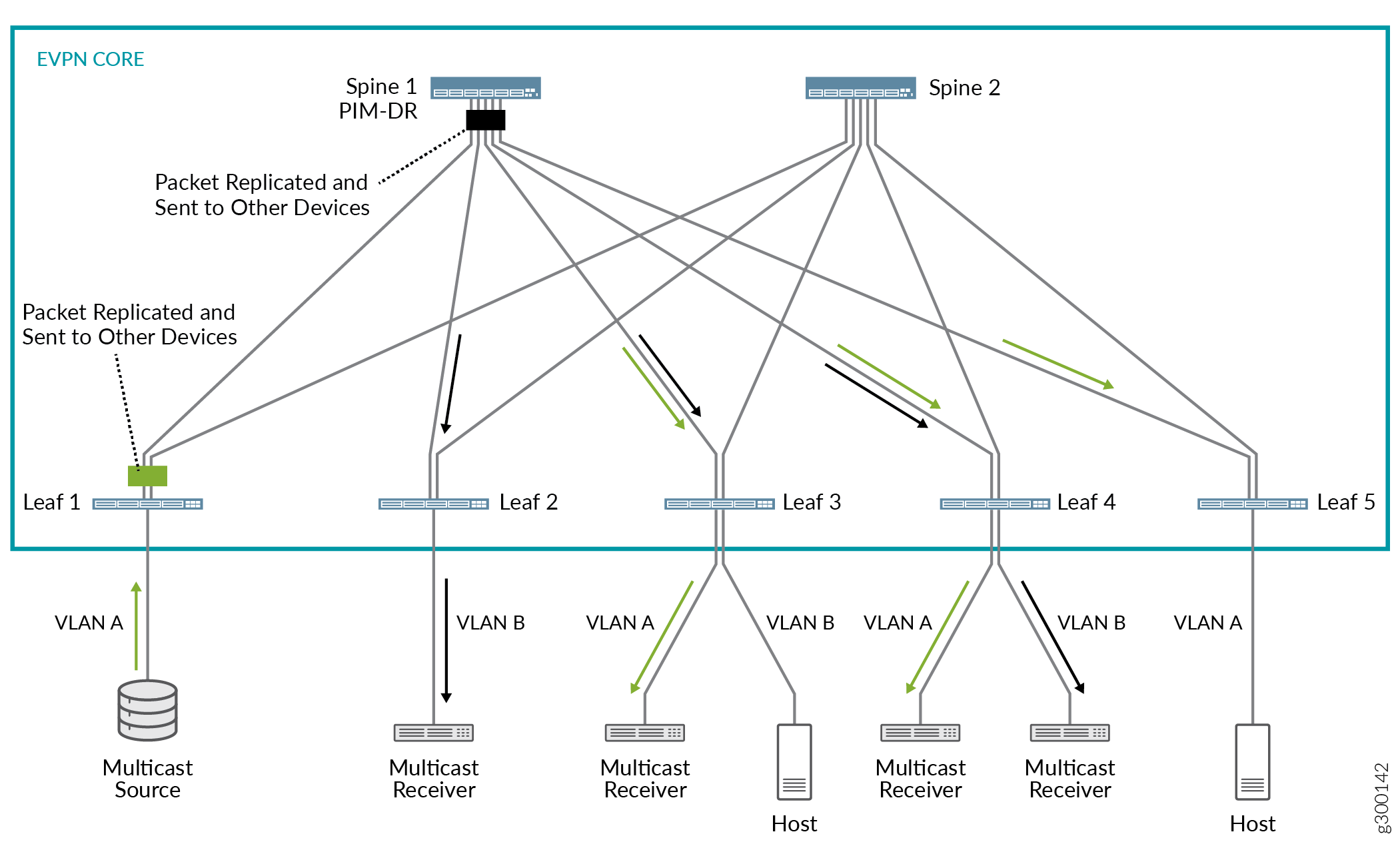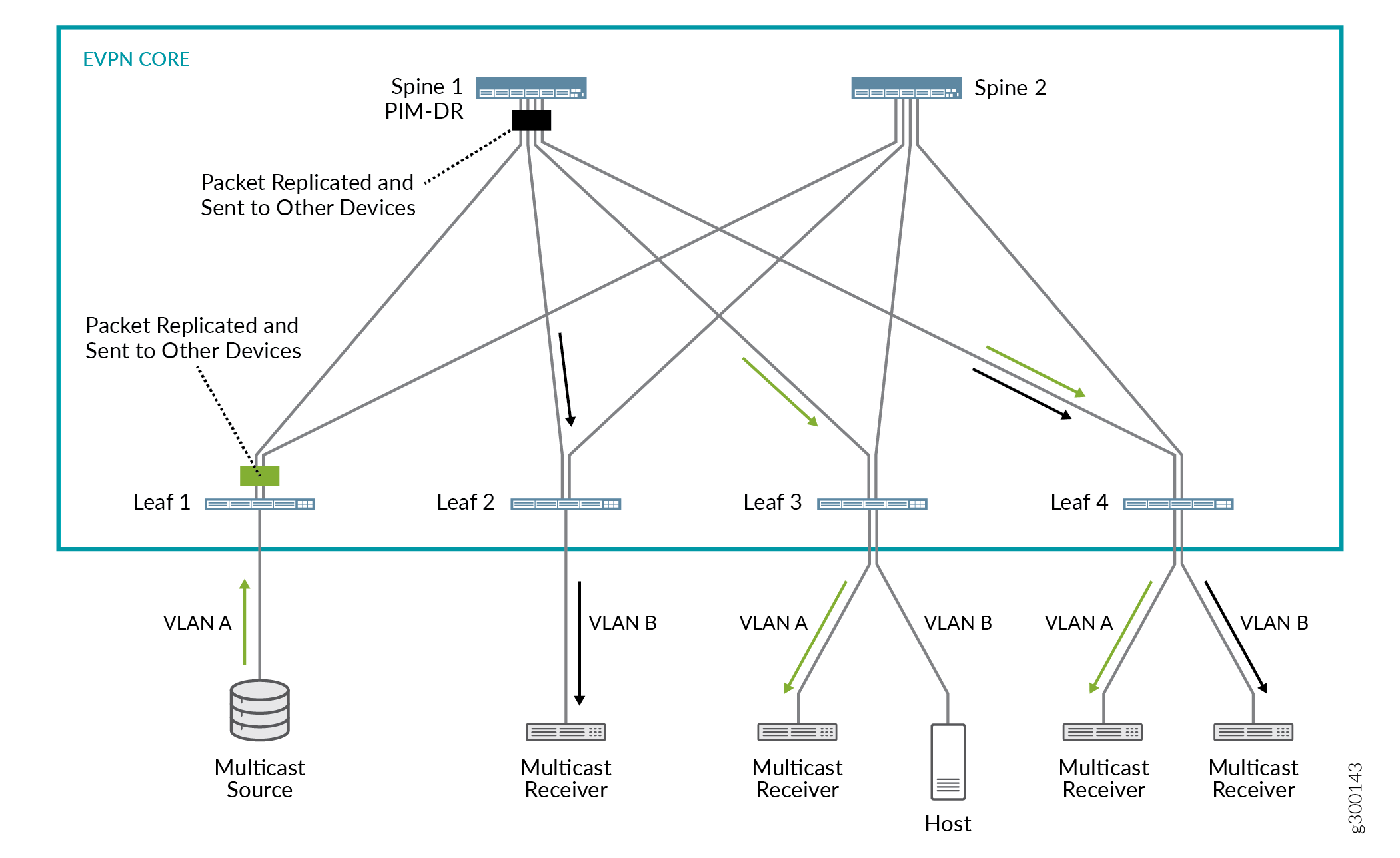Overview of Selective Multicast Forwarding
Prior to Junos OS Release 18.4R1, PE devices with IGMP snooping enabled only constrained the local multicast traffic going to its access interface. For intra-VLAN multicast traffic in a leaf-spine topology, when a leaf device receives multicast traffic from another device or from a multicast sender on one of its access interface, it replicates and forwards the multicast traffic to its own interfaces with interested receivers. The leaf device will also replicate and send the multicast traffic to all the leaf and spine devices in the EVPN core. For inter-VLAN multicast traffic, the spine device in a centrally routed EVPN-VXLAN network would route the multicast traffic between the VLANs through the IRB interface.
Figure 1 shows how inclusive multicast traffic flows in a centrally-routed EVPN network.

When the multicast source sends a packet from VLAN A, the following flows occur:
-
Flow 1: Intra-VLAN traffic—Based on the ingress replication mechanism, Leaf 1 replicates and switches the packet to all spine and other leaf devices. Leafs 3 and 4, on which VLAN A is configured, receive and forward the packet to the connected multicast receivers. Leaf 5, which is also on VLAN A network still receives the multicast packet even though there are no receivers.
-
Flow 2: Inter-VLAN traffic—Upon receipt of the packet from Leaf 1 as described in flow 1, Spine 1, which is the PIM DR, takes the following action:
-
Routes the packet over the IRB interface associated with VLAN B.
-
Based on the ingress replication mechanism, Spine 1 replicates and forwards the packet to the other spine and leafs.
Leafs 2 and 4, on which VLAN B is configured, receive and forward the packet to the connected multicast receivers. Leaf 3 receives the multicast packet, but does not forward the packet since it does not have a receiver.
-
Starting in Junos OS Release 18.4R1, devices with IGMP snooping enabled use selective multicast forwarding by default in a centrally routed EVPN-VXLAN network to replicate and forward multicast traffic.
Similarly, starting in Junos OS Release 20.4R1, QFX Series switches with MLD snooping enabled in a centrally routed EVPN-VXLAN network also enable selective multicast forwarding by default.
This is how selective multicast forwarding works with IGMP or MLD snooping on the leaf devices:
-
IGMP or MLD snooping allows leaf devices to send multicast traffic only to the access interface with an interested receiver.
-
When you enable IGMP or MLD snooping, a leaf device selectively sends multicast traffic to only the other leaf devices across the EVPN core that have expressed an interest in that multicast group.
-
With selective multicast forwarding, leaf devices also always send multicast traffic to a spine device so that the spine device can route inter-VLAN multicast traffic through its IRB interfaces.
Figure 2 shows how selective multicast traffic flows in a centrally-routed EVPN network.

When the multicast source sends a packet from VLAN A, the following flows occur:
-
Flow 1: Intra-VLAN traffic—Based on the ingress replication mechanism, Leaf 1 replicates and switches the packet to all spine and other leaf devices with interested receivers. In this case, leafs 3 and 4, on which VLAN A is configured and forward the packet to the connected interested multicast receivers.
-
Flow 2: Inter-VLAN traffic—Upon receipt of the packet from Leaf 1 as described in flow 1, Spine 1, which is the PIM DR, takes the following action:
-
Routes the packet over the IRB interface associated with VLAN B.
-
Based on the ingress replication mechanism, Spine 1 replicates and forwards the packet to the other spine and interested leaf devices.
Leafs 2 and 4, on which VLAN B is configured, receive and forward the packet to the connected multicast receivers. Leaf 3 does not have receivers and does not get a multicast packet.
-
Benefits of Selective Multicast Forwarding
Selective multicast forwarding provides greater network efficiency and reduces traffic in the EVPN network. Selective multicast forwarding conserves bandwidth usage in the core and reduces the load on egress PE devices that do not have listeners. The benefits of selective multicast forwarding increases when there are listeners in multiple VLANs.
Limitations of Selective Multicast Forwarding
-
Supported in a centrally-routed leaf-spine topology.
-
Support for EVPN-VXLAN encapsulation only.
-
Support for EVPN-ELAN services only.
-
Supported with IGMPv2, MLDv1, and MLDv2 traffic on particular QFX Series platforms and Junos OS releases.
